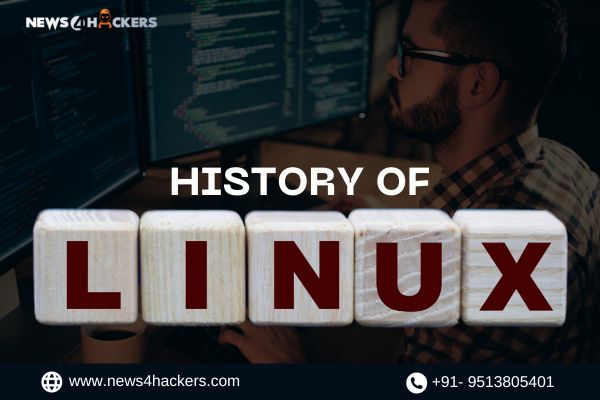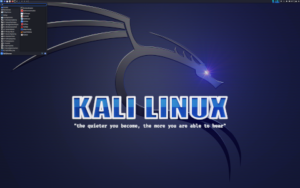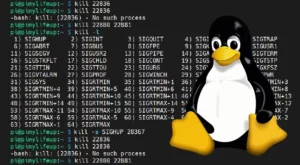History of Linux

History of Linux
Linux is well recognized as a prominent open-source operating system. The inception of this creation can be attributed to Linus Torvalds in the year 1991. During that period, Torvalds was enrolled as a computer science student at the University of Helsinki, Finland, where he initiated his involvement in the Linux project as an independent undertaking. The nomenclature “Linux” is derived from the amalgamation of the given name “Linus” and “Unix,” the foundational operating system that served as a source of inspiration for the aforementioned initiatives.
During that period, the majority of operating systems were characterized by their proprietary nature and high cost. Torvalds aspired to develop an operating system that would be accessible to all individuals interested in utilizing it. Consequently, he initially distributed Linux as open-source software, subject to the GNU General Public License. This implied that individuals had the freedom to utilize, alter, and disseminate the source code provided by them.

Initially, Linux was predominantly utilized by individuals with a keen interest in technology and software development. However, its widespread adoption has progressively increased, leading to its integration into a diverse range of devices including servers, smartphones, and embedded systems. Linux is widely acknowledged as an operating system that exhibits exceptional stability, security, and reliability, making it a preferred choice for deployment in servers, supercomputers, and enterprise settings. Currently, Linux stands as a highly prevalent operating system on a global scale. It is believed that Linux is utilized by approximately 2.76% of desktop computers worldwide, while an overwhelming majority of the world’s leading supercomputers, exceeding 90%, operate on Linux.
Furthermore, it is noteworthy that a substantial proportion, approximately 71.85%, of mobile devices are powered by Android, which is fundamentally founded on the Linux platform. The Linux community has experienced significant growth, encompassing a vast number of developers and users who actively contribute to the development and maintenance of the operating system. In the present era, Linux encompasses a multitude of distributions, each characterized by its own distinct version:
- Ubuntu
- Fedora
- Arch
- Plasma
- KDE
- Mint
- Manjaro
How Does Linux Work?
Consider the operating system as analogous to the engine of an automobile. The autonomous mobility of the engine is realized when it is integrated with the gearbox, axles, and wheels, thereby transforming it into a fully operational automobile. In the event of engine malfunction, the overall functionality of the vehicle may be compromised. The Linux operating system was initially developed with the intention of emulating the functionality of UNIX.
However, throughout time, it has undergone significant advancements to ensure compatibility with a wide range of hardware, spanning from mobile devices to high-performance supercomputers. Linux-based operating systems consist of a Linux kernel, responsible for managing hardware resources, and a collection of software packages that constitute the remaining components of the operating system. Organizations have the capability to utilize Linux operating systems on their Linux servers as well.
- Kernel: This particular element is an integral part of the comprehensive Linux operating system. The kernel, responsible for managing the central processing unit (CPU), memory, and peripheral devices, functions as the central control unit of the system. The kernel of an operating system is situated at the most fundamental level.
- Desktop Environment: The user actively participates in the interaction at this juncture. A wide range of desktop environments, such as GNOME, Cinnamon, Mate, Pantheon, Enlightenment, KDE, Xfce, and others, are currently accessible. Each desktop environment is equipped with pre-installed software applications, including file managers, configuration tools, web browsers, and games, among others.
Why Use Linux?
There exist multiple rationales for individuals opting to utilize the Linux operating system:

- Open-source: Linux is classified as open-source software, which denotes that the source code is readily accessible to all individuals for the purposes of utilization, alteration, and dissemination without any restrictions. This facilitates the formation of a substantial and dynamic community of developers who actively participate in the advancement and upkeep of the operating system.
- Customizability: Linux possesses a notable degree of customizability, affording users the ability to readily install and configure diverse software packages in accordance with their own requirements.
- Stability and security: Linux is renowned in the computing community for its exceptional stability and robust security measures, which contribute to its heightened resistance against system crashes and susceptibility to malware attacks compared to other operating systems.
- Cost-effective: Linux is available for download and usage at no cost, rendering it a financially advantageous alternative for both people and enterprises.
Events Leading to the Creation of Linux
The genesis of Linux, a highly prevalent open-source operating system globally, may be attributed to a series of significant occurrences and contributions made by a select group of individuals. Presented here is a concise overview of the principal occurrences that culminated in the genesis of the Linux operating system.
- Unix development: The Linux operating system was significantly impacted by the Unix operating system, which was originally developed by Bell Labs during the late 1960s and early 1970s. The Unix operating system was initially designed to support multiple users and concurrent tasks, making it a popular choice in the fields of science and research.
- Minix was born: During the early 1980s, Andrew S. Tanenbaum, a professor of computer science, developed a compact operating system named Minix, which exhibited similarities to the Unix operating system. Minix was created with the primary purpose of serving as an instructional instrument, with the intention of providing students access to its source code.
- Linux is born: In the year 1991, Linus Torvalds, a student aged 21, initiated the development of a novel operating system which he subsequently christened Linux. Linus drew inspiration from Minix and utilized its source code as a foundational framework for his personal undertakings. Furthermore, he extensively used Unix design concepts in his work.
- Release of Linux 0.01: The initial iteration of Linus’s Linux, known as Linux 0.01, was unveiled in September 1991. The operating system in question was a command-line interface (CLI) system that was made available for free distribution via the Internet.
- Linux community development: In subsequent years, Linux rapidly garnered favor and recognition within the programming community and among individuals with a strong interest in the subject matter. A collective of software developers emerged inside the Linux ecosystem, actively engaging in the advancement of the operating system through code authorship, bug reporting, and feedback provision.
- Enterprise Adoption: During the late 1990s and early 2000s, the inherent open-source characteristics of Linux rendered it a more adaptable, cost-efficient, and safe alternative to proprietary operating systems like Windows. Consequently, Linux gained significant traction among organizations and businesses. Commenced employment with various companies. The heightened level of adoption facilitated the emergence of commercial support and services catering to the Linux operating system.
- Linux Distribution Growth: With the increasing popularity of Linux, numerous developer organizations emerged and initiated the development of their distinct versions of the operating system, commonly referred to as distributions. Red Hat, Debian, and Ubuntu are among the distributions that have significant popularity. These distributions encompass the Linux kernel along with a variety of user-friendly tools and software packages, facilitating the ease of use of Linux for both developers and end users.
- Linux in the Enterprise: The increasing adoption of cloud computing and the Internet of Things has contributed to the growing prominence of Linux within the corporate sector. The Linux operating system has gained significant popularity and is currently extensively utilized in various domains, including servers, mainframes, and supercomputers. Furthermore, it finds applications in embedded systems, mobile devices, and the realm of the Internet of Things.
- Linux in the Consumer Market: The consumer market has witnessed the integration of Linux through the introduction of Linux-based mobile devices, smart TVs, and various other consumer goods.
Official Mascot of Linux
The designated representative symbol of the Linux operating system is a penguin character known as Tux. The penguin, which was initially used as the Linux mascot for the Linux kernel, was created by artist Larry Ewing in 1996. Tux rapidly gained popularity within the Linux community and has since become one of the most widely recognized symbols associated with the Linux operating system.
In addition, the selection of Tux as the mascot can be attributed to the penguin’s scarcity in its natural habitat of Antarctica, which parallels the distinctive and robust nature of the Linux operating system. The moniker “Tux” is derived from the abbreviated version “Torvalds Unix,” as a tribute to Linus Torvalds, the founder of the Linux operating system. Tux finds application in diverse situations, encompassing the representation of Linux operating system logos, the adornment of T-shirts, stickers, and other goods associated with Linux, and its incorporation into video games.
Development of Linux
The Linux ecosystem is characterized by its dynamic and progressive nature, with ongoing and extensive development activities. Significant recent advancements encompass:
- The release of the Linux 5.11 kernel. The updated version incorporates several enhancements, including support for the AMD Zen 3 processor, improvements to the memory management system, and expanded compatibility with new hardware.
- The ongoing advancement of diverse Linux distributions. The release of Ubuntu 21.04 occurred in the month of April in the year 2021. The operating system incorporates an enhanced Gnome desktop experience, enhanced support for the ZFS file system, and novel security enhancements.
- The present study focuses on the advancement of novel open-source software and tools specifically designed for the Linux operating system. As an illustration, the introduction of Ansible automation tools version 6.0 entails the inclusion of novel functionalities, including the incorporation of Windows Subsystem for Linux 2 (WSL2) support and enhanced compatibility with Kubernetes.
- The emergence and adoption of containerization and orchestration technologies, exemplified by Docker and Kubernetes, have witnessed a significant increase in recent times. The utilization and administration of Linux-based applications are increasingly prevalent.
- The utilization of Linux in the domain of cloud computing is experiencing a notable surge in popularity, as seen by the provision of Linux-based virtual machines and managed services by numerous prominent cloud providers.
Installing Linux
The process of installing an operating system may appear intimidating to a significant number of individuals. Contrary to popular belief, Linux is widely regarded as the most straightforward operating system to install. Indeed, the majority of Linux distributions provide a feature known as a live distribution. This entails the execution of an operating system from a CD/DVD or USB flash drive while refraining from making any modifications to the underlying hard drive.
All functionalities can be accessed without the need for installation. After conducting a trial and making a decision to use the software, proceed by double-clicking on the Install icon in order to initiate the execution of the straightforward installation wizard.
How News4Hackers Can Help?
News4Hackers is the leading Cybersecurity Info and News Portal. Craw Security is the sister vertical of News4Hackers providing world-class cybersecurity and Linux training programs and VAPT Solutions to all the necessary individuals and organizations throughout the world. With Craw Security’s high-profile training professionals, we can provide you with the Best Linux Education right from the House of Red Hat Incorporation. Craw Security is the accredited training partner of Red Hat Inc. to deliver its courses at very affordable prices. Thus, any interested fellow can contact Craw Security at their official website or 24X7 hotline mobile number +91-9513805401 and ask any query to their excellent team of educational counselors.

Conclusion
In a nutshell, we would love to comment that the invention of Linux by Linus Torvalds in 1991 has yielded substantial progress. Originally designed as a rudimentary operating system for personal computers, it has now evolved into a widely utilized and esteemed platform capable of supporting a diverse range of devices, spanning from supercomputers to mobile phones. The open-source nature of Linux has fostered a substantial and actively involved community of developers who have made significant contributions to its development and maintenance, resulting in a highly versatile and dependable operating system. Both consumers and organizations exhibit a preference for it due to its cost-effectiveness and versatility. Linux continues to maintain a prominent presence in the realm of technology, exerting a significant impact across several areas.
About The Author:
Yogesh Naager is a content marketer who specializes in the cybersecurity and B2B space. Besides writing for the News4Hackers blog, he’s also written for brands including CollegeDunia, Utsav Fashion, and NASSCOM. Naager entered the field of content in an unusual way. He began his career as an insurance sales executive, where he developed an interest in simplifying difficult concepts. He also combines this interest with a love of narrative, which makes him a good writer in the cybersecurity field. In the bottom line, he frequently writes for Craw Security.
READ MORE ARTICLE HERE








